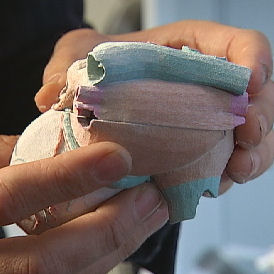How printing in 3-D could save lives
Tom Clarke reports on how the new printing technology that allows 3-D objects to be created from any flat scanned image – including the human heart – is starting a medical revolution.
At one print shop in London they don’t do calendars and wedding invites; they trade in three dimensions.
Any 3-D scan or computer drawing of an object can be literally printed off as a single object, no assembly required.
Born out of specialist manufacturing the 3-D Printing is now cheap enough to hit the high street.
A 3-D printer works just like an ordinary inkjet printer, converting a digital file into lines on a flat surface.
Only instead of ink it lays down a solid substance like plastic, metal, or plaster. With each pass the printer adds a layer while the surface moves down. The result: a 3-D object.
3-D printing has now evolved to a point where you can now walk in off the street with any idea you can imagine and within a matter of hours they can make it real.

Medical value
At the University of Warwick they’re printing parts of the human body, including the human heart. Using this technology they can reproduce any part of any person’s anatomy.
So what start’s out virtually as a digital scan on a computer is sent to the 3-D printer where it becomes reality that you can hold in your hands.
For several years engineers at the university have been tinkering with the powers of 3-D printing.
But late last year the neighbouring hospital called. An accident victim had just arrived with a badly crushed pelvis – a life threatening injury. They had a simple question:
“Could we reproduce for them the pelvis in 3-D that the surgeon could then use to plan his surgery?”
Dr Greg Gibbons, University of Warwick
Based on a CT scan engineers printed-off a copy of the damaged pelvis – the first time doctors have used the technology to save crucial time in an emergency.
“What we wanted to see if this could allow the surgeons to understand this, so they could work out where to make the incision and had already planned the operation.”
Dr Richard Wellings, University Hospital Coventry
And here in the brand new West Midlands Surgical Training Centre 3-D printing could find a permanent home. Preserved human organs like this heart, used to teach anatomy to surgeons, are very precious objects.
“The idea that we could scan this and make an exact replica means we could make lots of these and give them to the students for learning.”
Prof Peter Abrahams
Warwick Medical School
Now doctors and engineers here at Warwick want to replace this 3D printing powder with the chemical constituents of human bone – so they can print perfectly matched bionic components to replace broken or damaged bones.
As manufacturers explore new ways to print truly working parts one day it doctors could be printing spares for the human body.
-
Latest news
-
Laughing Boy: New play tells the tragic tale of Connor Sparrowhawk5m

-
Sewage warning system allows some of worst test results to be left off rating system, analysis shows3m

-
Post Office inquiry: Former CEO didn’t like word “bugs” to refer to faulty IT system4m

-
Israeli soldier speaks out on war in Gaza12m

-
PM’s defence spending boost should be ‘celebrated’, says former Armed Forces Minister4m

-




